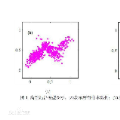This paper compares the continuum evolution for density equation modelling and the Gaussian mixture model on the 2D phase space long-term density propagation problem in the context of high-altitude and high area-to-mass ratio satellite long-term propagation. The density evolution equation, a pure numerical and pointwise method for the density propagation, is formulated under the influence of solar radiation pressure and Earth's oblateness using semi-analytical methods. Different from the density evolution equation and Monte Carlo techniques, for the Gaussian mixture model, the analytical calculation of the density is accessible from the first two statistical moments (i.e., the mean and the covariance matrix) corresponding to each sub-Gaussian distribution for an initial Gaussian density distribution. An insight is given into the phase space long-term density propagation problem subject to nonlinear dynamics. The efficiency and validity of the density propagation are demonstrated and compared between the density evolution equation and the Gaussian mixture model with respect to standard Monte Carlo techniques.
翻译:本文比较了密度方程建模的连续演进和2D阶段空间长期密度传播问题的高斯混合物模型,在高纬度和高面积对质比卫星长期传播的背景下,对2D空间长期密度传播问题进行了分析。密度演进方程,这是密度传播的纯数字和点法,是在太阳辐射压力和地球悬浮作用的影响下,使用半分析方法制定的。与密度演进方程和蒙特卡洛技术不同,对于高斯混合物模型,从头两个统计时刻(即平均和共变矩阵)即可获得密度的分析计算,与戈西亚最初密度分布的每一种亚-高斯密度分布相对应。对空间长期密度传播问题进行了深入了解,但须有非线性动态。密度传播的效率和有效性与标准蒙特卡洛技术的密度进化方程和高斯混合模型相比较。





